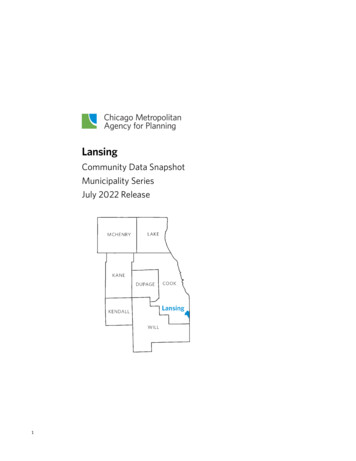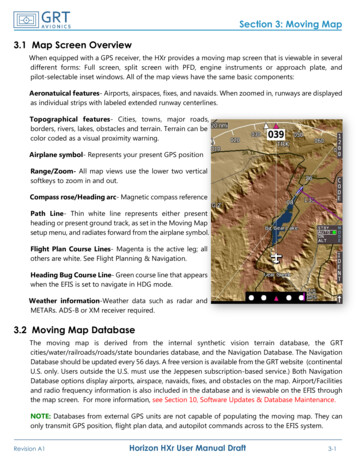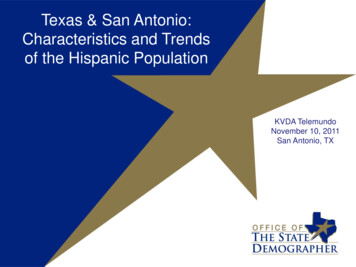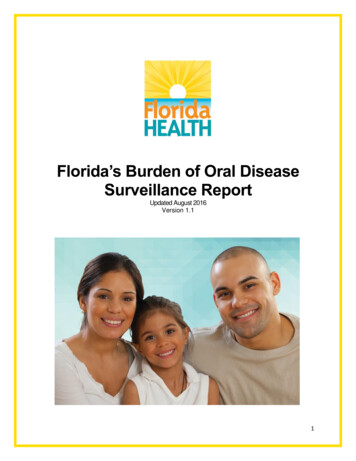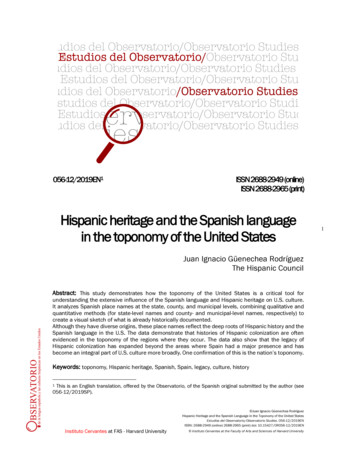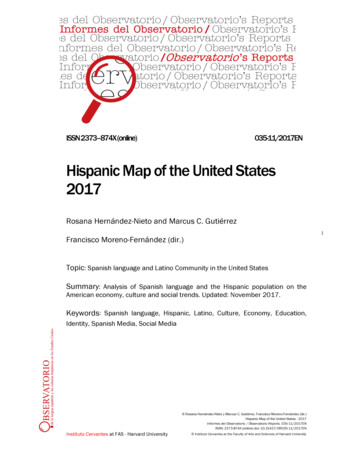
Transcription
ISSN 2373–874X (online)035-11/2017ENHispanic Map of the United States2017Rosana Hernández-Nieto and Marcus C. Gutiérrez1Francisco Moreno-Fernández (dir.)Topic: Spanish language and Latino Community in the United StatesSummary: Analysis of Spanish language and the Hispanic population on theAmerican economy, culture and social trends. Updated: November 2017.Keywords: Spanish language, Hispanic, Latino, Culture, Economy, Education,Identity, Spanish Media, Social Media Rosana Hernández-Nieto y Marcus C. Gutiérrez. Francisco Moreno-Fernández (dir.)Hispanic Map of the United States - 2017Informes del Observatorio / Observatorio Reports. 035-11/2017ENISSN: 2373-874X (online) doi: 10.15427/OR035-11/2017ENInstituto Cervantes at FAS - Harvard University Instituto Cervantes at the Faculty of Arts and Sciences of Harvard University
IntroductionThis report examines the situation of the Spanish language and the Hispanicpopulation in the U.S. through the trends observed in the United States over thelast decades. In particular, this work examines data about Hispanic populationdemography and language use, educational attainment, use of the Internet andsocial media, economic and socioeconomic trends, Hispanic presence in politicsand Spanish-language media in the U.S.The fast growth of Hispanic population is already altering the ethnic makeup ofthe nation. As the proportion of Hispanic-Americans increases and that of whiteAmericans declines, the Spanish language will reach larger proportions of theU.S. population. It is important for an accurate analysis to take demographictrends into consideration: U.S. born Hispanics account for most of the Latinopopulation growth, and it is known that they become increasingly Englishdominant by the third and later generations. Identity issues are also relevant inorder to examine the future of the Spanish-language in the country: while 71% ofLatinos say speaking Spanish is not necessary to be considered Hispanic, 70% ofthe U.S. population thinks being able to speak English is very important for beinga truly American.The factors, length of time in the U.S., educational attainment, income andlanguage ability strongly determine the success of Latinos in the United States,more so than does ethnicity and language use alone. Those who complete highschool and attain higher degrees gain proficiency in English and grow up infamilies with higher income, are more likely to succeed. In general, this alsotends to be combined with less frequent use of Spanish, as well as a greaterlikelihood to consider oneself “American.”Nevertheless, despite strong indicators of progress in economic and educationalissues, Hispanics still lag behind the other major racial and ethnic groups in a Rosana Hernández-Nieto y Marcus C. Gutiérrez. Francisco Moreno-Fernández (dir.)Hispanic Map of the United States - 2017Informes del Observatorio / Observatorio Reports. 035-11/2017ENISSN: 2373-874X (online) doi: 10.15427/OR035-11/2017ENInstituto Cervantes at FAS - Harvard University Instituto Cervantes at the Faculty of Arts and Sciences of Harvard University2
number of key areas. One of particular concern is educational attainment. Ahigher level of education is correlated with higher income, better job prospects,higher proficiency in the English language, and better quality of life indicators.The inability to correct the education gap for American Latinos will likely impairthis community’s ability to maintain a strong path to assimilation.Hispanics are far from attaining the political power they should hold given theirdemographic weight. Despite symbolic acts, such as candidates speakingSpanish during the presidential campaign in 2016, both the limited Hispanicpresence in swing states and the demographic characteristics lined to lowturnout are limiting Latinos from reaching more influence at a federal level.Furthermore, Hispanics are being especially impacted by Donald Trump’sdecisions, particularly those relating to immigration issues.Finally, this report also elaborates on the use of the Internet and social media byHispanics. It is also of great significance to this report the state of the Spanishlanguage media, which is analyzed in a study of Spanish Journalism in the UnitedStates conducted by the Cervantes Observatory at Harvard University. This studyreveals that a lack of quality use of Spanish in print and digital media is causing asignificant reduction in readership and the use of Spanish in the U.S. For generalinformation and knowledge, the content of this report is divided and ordered inthe following sections:1This report examines data from a number of sources including the U.S. Census Bureau, the PewResearch Center, and the National Center for Education Statistics to more accurately present thecurrent state of Hispanics across the United States. The terms Latino and Hispanic are usedinterchangeably in this report, as are U.S.-born and native-born. The terms foreign-born,immigrant, and migrant are also used interchangeably in this report. Foreign-born is used toindicate someone born outside of the U.S. and Puerto Rico. “English-dominance” or “Spanishdominance” is used to indicate when knowledge or use of one language is stronger than theother. “Bilingual” is used to indicate when both Spanish and English are spoken equally well. Inmost instances throughout this report, language dominance was determined by self-reportedsurveys submitted to the U.S. Census Bureau or the Pew Research Center.1 Rosana Hernández-Nieto y Marcus C. Gutiérrez. Francisco Moreno-Fernández (dir.)Hispanic Map of the United States - 2017Informes del Observatorio / Observatorio Reports. 035-11/2017ENISSN: 2373-874X (online) doi: 10.15427/OR035-11/2017ENInstituto Cervantes at FAS - Harvard University Instituto Cervantes at the Faculty of Arts and Sciences of Harvard University3
1. Population Demographicsi.Rate of Population Growthii.Immigration vs. Natural Birthsiii.Ageiv.Population by Statev.Countries of Origin2. Language Use and Abilityi.Backgroundii.Spanish among Hispanicsiii.English among Hispanicsiv.Barriers to English Proficiencyv.Spanish Language Study in the United States3. Educational Attainmenti.Primary and Secondary Enrollment and Completionii.College Level Enrollmentiii.Gender, Race and Education4. Economic and Socioeconomic Trendsi.Purchasing Powerii.Income and Povertyiii.Gender Pay Gapiv.Home Ownershipv.Health Insurancevi.Marriage5. Politicsi.Context of U.S. Latino Politicsii.The Latino Vote in the 2016 Presidential Electionsiii.Hispanic Political Representativesiv.White House Spanish Language Website6. Identity and Social Attitudesi.Hispanic vs. Latinoii.Who is Hispanic in the U.S.?7. Technology: Internet and Social Media Usei.Internet Useii.Smartphone Useiii.Social Media Use8. Media and Publicationsi.News and Languageii.Newspapersiii.Television Newsiv.Digital Newsv.Television and Languagevi.Radiovii.Music9. Conclusion Rosana Hernández-Nieto y Marcus C. Gutiérrez. Francisco Moreno-Fernández (dir.)Hispanic Map of the United States - 2017Informes del Observatorio / Observatorio Reports. 035-11/2017ENISSN: 2373-874X (online) doi: 10.15427/OR035-11/2017ENInstituto Cervantes at FAS - Harvard University Instituto Cervantes at the Faculty of Arts and Sciences of Harvard University4
1. Population Demographics According to the U.S. Census Bureau, in 2017 Hispanics made up 17.8%of the population in the United States, approximately 57.5 million. The Latino population is expected to account for 26.5% of the U.S.population by 2060. In recent years the number of U.S.-born Hispanics is growing more quicklythan the number of Hispanic immigrants. The median age of Hispanics (28.9) is younger than that of United Statespopulation (37.9). The five U.S. states with the largest Hispanic population in 2016 were:California (15.3 million), Texas (10.9 million), Florida (5,1 million), NewYork (3.7 million) and Illinois (2.2 million).Rate of Population GrowthAbout 57.5 million Hispanics live in the United States out of a total population of323.1 million Americans (U.S. Census Bureau 2017a). This figure is expected todouble within the next 30-40 years, to approximately 106 million out of 398million in 2050 (U.S. Census Bureau 2014). This projected shift would raise thenumber of Latinos from 17.8% of the U.S. population to over a quarter of thepopulation, at 26.6%.From 2000 to 2012, the Hispanic population grew by 50% while the entire U.S.population grew only by 12% (Brown 2014), and between 1970 and 2016 theHispanic population increased more than six-fold, from 9.1 million to 57.5 million.The Hispanic population is further projected to grow to 106 million by 2050, andto reach 119 million by 2060, according to the latest projections from the U.S.Census Bureau (U.S. Census 2014). The share of Hispanics in the U.S. Rosana Hernández-Nieto y Marcus C. Gutiérrez. Francisco Moreno-Fernández (dir.)Hispanic Map of the United States - 2017Informes del Observatorio / Observatorio Reports. 035-11/2017ENISSN: 2373-874X (online) doi: 10.15427/OR035-11/2017ENInstituto Cervantes at FAS - Harvard University Instituto Cervantes at the Faculty of Arts and Sciences of Harvard University5
population, currently is at 17.8%, but is expected to reach 26.5% by 2050 and upto 28.6% by 2060 (Colby and Ortman 2015; U.S. Census Bureau 2017a).Figure 1. U.S. population forecast by race/ethnicity until 2060. Source: U.S. CensusBureau panic#2050#2055#2060#Other#This corresponds more broadly to a large demographic shift within the UnitedStates. Until the 1980s, whites of European descent are estimated to have madeup approximately 80-90% of the U.S. population: in 2010, the proportion of nonHispanic whites, here on referenced simply as whites, in the U.S. had fallen to64.1%, and to 61.1% in 2016. By 2045, some analysts have estimated thatWhites will make up less than half of the U.S. population (The Economist 2015a;Colby and Ortman 2015; U.S. Census Bureau-ACS 2016: DP05). Rosana Hernández-Nieto y Marcus C. Gutiérrez. Francisco Moreno-Fernández (dir.)Hispanic Map of the United States - 2017Informes del Observatorio / Observatorio Reports. 035-11/2017ENISSN: 2373-874X (online) doi: 10.15427/OR035-11/2017ENInstituto Cervantes at FAS - Harvard University Instituto Cervantes at the Faculty of Arts and Sciences of Harvard University6
Figure 2. U.S. Hispanic population, in millions. Source: U.S. Census Bureau-ACS 2016:DP05.70.0 57.5 60.0 50.5 50.0 35.3 40.0 30.0 22.4 20.0 10.0 14.6 9.1 0.0 1970 1980 1990 2000 2010 2016 Hispanics are the nation’s largest minority and until recently, comprise thenation’s fastest growing population, only recently surpassed by the growth amidthe Asian population (Stepler and Lopez 2016). While the general U.S. birth rateis below replacement level2, the birth rate among Hispanics remains the only oneabove it, at 2,123.5 total fertility rate (Martin et al. 2017). All this suggests thatHispanic population will continue being the fastest-growing population in the U.S.(The Economist 2015a). It is important to note that the Hispanic women birth rateis decreasing: from 98.3 births per 1,000 in 2006, to 71.7 in 2015 (Krogstad2017).“Total Fertility Rate estimates the number of births that a group of 1,000 women would haveover their lifetimes, base don age-specific births rates in a given year” (Martin et al. 2017: 5).2 Rosana Hernández-Nieto y Marcus C. Gutiérrez. Francisco Moreno-Fernández (dir.)Hispanic Map of the United States - 2017Informes del Observatorio / Observatorio Reports. 035-11/2017ENISSN: 2373-874X (online) doi: 10.15427/OR035-11/2017ENInstituto Cervantes at FAS - Harvard University Instituto Cervantes at the Faculty of Arts and Sciences of Harvard University7
Figure 3. U.S. population estimates by percent and race/ethnicity until 2016. Source:U.S. Census Bureau-ACS 2016: c#8Immigration vs. Natural BirthsDespite the continuous growth of the Latino population in the United States, in awave of 59 million immigrants in nearly five decades, and a record of 57.7 millionHispanics living in the United States as of 2016, growth has slowed. According tothe last data by the Center for Immigration Studies, immigration from LatinAmerica experienced an increase of 5% between 2010 and 2016, which showsan important slowdown compared to the increase of 31.9% between 2000 and2010. On the other side, considering return immigration and natural mortality,the overall Mexican-born population decreased 1% between 2010 and 2016(Camarota and Zeigler 2017). Thus with fewer arrivals, the U.S Census has had tolower Hispanic population projections for 2050 from 133 million in 2008 to 112million in 2012. Rosana Hernández-Nieto y Marcus C. Gutiérrez. Francisco Moreno-Fernández (dir.)Hispanic Map of the United States - 2017Informes del Observatorio / Observatorio Reports. 035-11/2017ENISSN: 2373-874X (online) doi: 10.15427/OR035-11/2017ENInstituto Cervantes at FAS - Harvard University Instituto Cervantes at the Faculty of Arts and Sciences of Harvard University
While the majority of historical Latino population growth in the United States wasdriven by immigration, this is no longer the case. According to the Pew ResearchCenter, the number of Latino immigrants reached a record of 18.8 million in2010 but has since stalled (Krogstad and Lopez 2014). The constant Hispanicpopulation growth has been driven mainly by U.S. Hispanics births in the lastyears, which will have relevant implications for some quality of life indicators, asthis report examines, among others, language proficiency, educationalattainment, income, home ownership, and identity. Figure 4, based on data fromthe Pew Research Center and the U.S. Census, shows Hispanic populationgrowth, in millions, broken down by nativity (immigration and natural U.S. births).Figure 4. Hispanic natural births vs. Immigration, in millions. Source: Krogstad andLópez 2014.12.0 9.6 10.0 98.1 8.0 7.0 6.0 4.0 6.5 5.6 U.S. births 4.4 Immigra9on 3.1 3.1 2.0 0.0 1970s 1980s 1990s 2000s According to the U.S. Census Bureau, immigration from both China and India overtook that from Mexico in 2013 (The Economist 2015b). In 2015, 110,000immigrants came from India, followed by 109,000 from Mexico, and 90,000 fromChina (López and Bialik 2017). As the main driver of Hispanic population growth,the decline in the number of Mexicans entering the United States contributes to Rosana Hernández-Nieto y Marcus C. Gutiérrez. Francisco Moreno-Fernández (dir.)Hispanic Map of the United States - 2017Informes del Observatorio / Observatorio Reports. 035-11/2017ENISSN: 2373-874X (online) doi: 10.15427/OR035-11/2017ENInstituto Cervantes at FAS - Harvard University Instituto Cervantes at the Faculty of Arts and Sciences of Harvard University
an overall decline of the Hispanic immigration rate (Pew Research Center 2014).Though they continue to be the largest group among Hispanics, with a populationat 34 million (The Economist 2015a). The Mexican-American population hasexpanded so quickly that since 2005, Mexico has opened up five new consulatesacross the United States (The Economist 2015c).According to the Pew Research Center, Hispanic and Asian populations willcontinue driving demographic growth in the U.S., even though the percentage offoreign-born Hispanics and Asians is expected to decrease; that means thepopulation growth will be due to U.S. births in both groups. The proportion offoreign-born Hispanics of all ages decreased to 35.5% in 2012, fromapproximately 40% in the early 2000s (Krogstad and López 2014). Thatproportion was 34.5% in 2015, and the U.S. Census Bureau expects it to declineto 27.4% in 2060 (Brown 2015; Krogstad 2017). Hispanic population increasedin almost 7 millions between 2010 and 2016; 76,8% of it was due to U.S. birthsand only 23.2% due to immigration (U.S. Census Bureau/American FactFinder2016: PEPCCOMPN). Figure 5 below shows the estimated Hispanic population (inmillions) by nativity from 1960-2015.These figures could be deeply impacted if new immigration laws are passed withmore restrictive conditions to enter the U.S. than the current one: the Immigrationand Nationality Act from 1965. The Reforming American Immigration for StrongEmployment Act or RAISE act, introduced in the Senate by two RepublicanSenators and supported by the President of the United States, Donald Trump,would impose hard restrictions on non qualified immigration, as well as onfamiliar reunification; it would also require certain English proficiency, allrequirements that could strongly influence Hispanic migration (Calcino 2017). Rosana Hernández-Nieto y Marcus C. Gutiérrez. Francisco Moreno-Fernández (dir.)Hispanic Map of the United States - 2017Informes del Observatorio / Observatorio Reports. 035-11/2017ENISSN: 2373-874X (online) doi: 10.15427/OR035-11/2017ENInstituto Cervantes at FAS - Harvard University Instituto Cervantes at the Faculty of Arts and Sciences of Harvard University10
Figure 5. Hispanic population estimates in millions, by nativity, 1960-2015. Source:Stepler and Brown U.S."born"2000"2010"2015"Foreign"born"AgeAnother significant statistic of Hispanic population growth is that Hispanics arethe youngest demographic group in the United States. In 2016, the median agefor Hispanics in the U.S. was 28.9 years, compared to 43.4 for whites, 33.9 forblacks, 36.9 for Asians, and 37.9 for the entire U.S. population (U.S. CensusBureau/American FactFinder 2016: B01002I). In addition, the median age ofU.S. born Hispanics is actually lower than that for those who are foreign born, at19 years and 40 years, respectively (Krogstad, Stepler y López 2015; Stepler yBrown 2016). In 2014, there were almost twice as many U.S.-born as foreignborn Hispanics, a comparison of 37.7 million to 19.6 million, and those born inthe U.S. made up 65.8% of the U.S. Hispanic population. Consequentially, twothirds of the U.S. Latino community is substantially younger than otherdemographics in the United States. Rosana Hernández-Nieto y Marcus C. Gutiérrez. Francisco Moreno-Fernández (dir.)Hispanic Map of the United States - 2017Informes del Observatorio / Observatorio Reports. 035-11/2017ENISSN: 2373-874X (online) doi: 10.15427/OR035-11/2017ENInstituto Cervantes at FAS - Harvard University Instituto Cervantes at the Faculty of Arts and Sciences of Harvard University11
Population by StateHispanics tend to be concentrated in the Western states (California, Texas, NewMexico and Arizona, among others). Previously clustered in a few key cities andstates, Hispanic population has now spread more broadly across the UnitedStates, especially to the South West; this trend has slowed down since the GreatRecession (Krogstad 2017). Figure 6 shows a map of the Hispanic populationacross the United States. The counties with the largest Hispanic population tendto be concentrated in the Southwest of the country and also in Southern Florida.Figure 6. Distribution of U.S. Hispanic population by counties as of ACS 2015 (5-yearsestimates).12New Mexico has the largest number of Hispanics as a portion of the overallpopulation, at 48.5%, while California has the largest overall number ofHispanics, at 15,3 million (U.S. Census Bureau/American FactFinder 2016:PEPASR6H). From 2000-2010, the Hispanic population has grown most rapidly inthe South and in the Middwest (Hispanic Association of Colleges and Universities Rosana Hernández-Nieto y Marcus C. Gutiérrez. Francisco Moreno-Fernández (dir.)Hispanic Map of the United States - 2017Informes del Observatorio / Observatorio Reports. 035-11/2017ENISSN: 2373-874X (online) doi: 10.15427/OR035-11/2017ENInstituto Cervantes at FAS - Harvard University Instituto Cervantes at the Faculty of Arts and Sciences of Harvard University
2017). Northeastern counties, predominately those in Pennsylvania, New Jerseyand New York, demonstrated a larger share of national Hispanic growth post2007 than during the period 2000-2007 (Stepler and Lopez 2016). Notably, thethree counties demonstrating the greatest growth in their Hispanic populationwere all found in North Dakota.In 2016, the five U.S. states with the largest Hispanic population were: California(15.3 million), Texas (10.9 million), Florida (5.1 million), New York (3.7 million)and Illinois (2.2 million) (U.S. Census Bureau/American FactFinder 2016:PEPASR6H). The states where Hispanics made up the largest share of the population (in 2016) were: New Mexico (48.5%), Texas (39.1%), California (38.9%),Arizona (30.5%) and Nevada (28.5%) (U.S. Census Bureau/American FactFinder2016: PEPASR6H). More than 50% of U.S. Hispanics live in California, Florida andTexas; adding New York, Arizona, Illinois, New Jersey and Colorado to the groupincorporates over 75% of all Hispanics in the United States (Hispanic Associationof Colleges and Universities 2017). Between 2000 and 2015, the states with thefastest-growing Hispanic populations were Georgia (118.8%), Florida (85.6%),Texas (60.4%), Arizona (62.4%) y Colorado (58.4%) (Flores 2017).Table 1. Hispanic Population by U.S. state. Source: U.S. Census Bureau/AmericanFactFinder 2016: PEPASR6H.12345678910EstadoHispanic population 2015Hispanic population 2016CaliforniaTexasFloridaNew YorkIllinoisArizonaNew JerseyColoradoNew 2,144,7751,786,6681,181,2191,009,873972,698 Rosana Hernández-Nieto y Marcus C. Gutiérrez. Francisco Moreno-Fernández (dir.)Hispanic Map of the United States - 2017Informes del Observatorio / Observatorio Reports. 035-11/2017ENISSN: 2373-874X (online) doi: 10.15427/OR035-11/2017ENInstituto Cervantes at FAS - Harvard University Instituto Cervantes at the Faculty of Arts and Sciences of Harvard University13
Table 2. Hispanics as a percentage of population by U.S. state. Source: U.S. CensusBureau/American FactFinder 2016: PEPASR6H.StateHispanic population1New vadaFlorida30.5%28.5%24.9%7Colorado21.3%8New Jersey20%910New YorkIllinois19%17%Table 3. U.S. counties with largest Hispanic population. Source: U.S. CensusBureau/American FactFinder 2016: PEPASR6H.CountyHispanic population1Los Ángeles, CA4,918,8302Harris County, TX1,945,6213Miami-Dade County, FL1,835,4134Cook County, IL1,318,8795Maricopa County, AZ1,302,4196Riverside County, CA1,156,1697Bexar County, TX1,155,9978San Bernardino County, CA1,129,8939San Diego County, CA1,112,32510Orange County, CA1,086,961Countries of originU.S. Hispanics trace their heritage to more than twenty Spanish-speakingcountries. Of these groups, six have populations in the U.S. greater than one Rosana Hernández-Nieto y Marcus C. Gutiérrez. Francisco Moreno-Fernández (dir.)Hispanic Map of the United States - 2017Informes del Observatorio / Observatorio Reports. 035-11/2017ENISSN: 2373-874X (online) doi: 10.15427/OR035-11/2017ENInstituto Cervantes at FAS - Harvard University Instituto Cervantes at the Faculty of Arts and Sciences of Harvard University14
million. The 14 largest origin groups are listed below in Table 4. Arrivals anddescendants from these 14 countries account for 95% of the U.S. Hispanicpopulation.Table 4. U.S. Hispanic population by country of origin, in miles. Source: U.S. CensusBureau/American FactFinder 2016: B03001.Country of OriginNum ber% of HispanicsMexico36,255,58963.2%Puerto Rico5,450,4729.5%Cuba2,212,5663.9%El Salvador2,195,4773.7%Dominican 398,719As immigration from Mexico continues to decrease, the percentage of Hispanicsof Mexican origin has decreased to 63.2% or 36.3 million (U.S. CensusBureau/American FactFinder 2016: B03001). The second biggest source ofHispanic population in the U.S. are Puerto Ricans whose number has increased to5.4 million, then follow Salvadorians, Cubans, Dominicans, and Guatemalans.Hispanics from Paraguayan, Uruguayan, Bolivian, and Costa Rican origin, makeup less than 200,000 in all cases.Table 5 and Figure 7 give the numbers and percentages of Hispanics accordingto country or region of origin. Rosana Hernández-Nieto y Marcus C. Gutiérrez. Francisco Moreno-Fernández (dir.)Hispanic Map of the United States - 2017Informes del Observatorio / Observatorio Reports. 035-11/2017ENISSN: 2373-874X (online) doi: 10.15427/OR035-11/2017ENInstituto Cervantes at FAS - Harvard University Instituto Cervantes at the Faculty of Arts and Sciences of Harvard University15
Table 5. U.S. Hispanic population by region of origin. Source: U.S. CensusBureau/American FactFinder 2016: B03001.RegionNum berMexico36.255.589Puerto RicoCentral America5.450.4725.319.873CubaDominican RepublicSouth gure 7. U.S. Hispanic population by origin. Source: U.S. Census Bureau/AmericanFactFinder 2016: ica%63.2%Other% Rosana Hernández-Nieto y Marcus C. Gutiérrez. Francisco Moreno-Fernández (dir.)Hispanic Map of the United States - 2017Informes del Observatorio / Observatorio Reports. 035-11/2017ENISSN: 2373-874X (online) doi: 10.15427/OR035-11/2017ENInstituto Cervantes at FAS - Harvard University Instituto Cervantes at the Faculty of Arts and Sciences of Harvard University16
2. Language Use and Ability Spanish is the first non-English language in the United States. According to the 2016 American Community Survey, there are 40.5 millionSpanish speakers in the U.S., without considering undocumentedimmigrants. 76% of Hispanics are Spanish-dominant or bilingual. 95% of U.S. Hispanics believe it is important for future generations tocontinue to speak Spanish. By the third generation the percentage of Hispanics who are Spanishdominant or bilingual declines significantly: just one third considersthemselves bilingual and only 47% say they speak Spanish proficiently.BackgroundIt is difficult to precisely calculate the current number of Spanish speakers in theUnited States and the growth of this demographic, particularly among nonHispanics that have come to dominate Spanish but do not speak it at home.There is additional difficulty counting the number of foreign-born Hispanics thatmay have immigrated to the U.S. at a young age and do not have mastery overSpanish, but nevertheless under the Census are assumed to speak Spanish.Thus, the numbers in the Census and the American Community Survey (ACS)should only be seen as rough estimates.The U.S. Census introduced a self-rating question in 1980 in order to quantify thenumber of speakers of the different languages in the United States, as well as theEnglish proficiency of non-English speakers. The English-ability question’s validityhas been examined and validated by various analyses (Vickstrom, Shin, Collazo yBauman 2015). Figure 8 presents the three questions used to determinerespondents’ language use in the Census and the ACS. Even though there are Rosana Hernández-Nieto y Marcus C. Gutiérrez. Francisco Moreno-Fernández (dir.)Hispanic Map of the United States - 2017Informes del Observatorio / Observatorio Reports. 035-11/2017ENISSN: 2373-874X (online) doi: 10.15427/OR035-11/2017ENInstituto Cervantes at FAS - Harvard University Instituto Cervantes at the Faculty of Arts and Sciences of Harvard University17
limitations, U.S. Census comprises the most reliable data of language use in theUnited States.Figure 8. Reproduction of the Questions on Language in the U.S. Census Bureau’sAmerican Community Survey. Source: U.S. Census Bureau/ACS 2017.18A study of the Census Data for 2011, estimates that there are about 48.6 millionSpanish speakers in the United States (Escobar and Potowski 2015). Thisnumber includes records of the US Census Bureau’s 2011 American CommunitySurvey (ACS), of Hispanics age five or older, who are foreign-born (18.7 million)and native-born (17 million) that speak Spanish at home (Escobar and Potowski2015). Additionally, this estimate includes Spanish speakers who are notreported in the Census, Hispanic undocumented immigrants, and non-Hispanicswho speak Spanish at home (2.8 million in 2011 and 2.6 million in 2013)(Krogstad and González-Barrera 2015).According to 2016 ACS, 37.9 million of Hispanics older than 5 years old speakSpanish at home (U.S. Census Bureau/American FactFinder 2016: C16006);adding 2.6 million of Non-Hispanic population speaking Spanish, the number isabout 40.5 million. Undocumented immigrants should be also taken in Rosana Hernández-Nieto y Marcus C. Gutiérrez. Francisco Moreno-Fernández (dir.)Hispanic Map of the United States - 2017Informes del Observatorio / Observatorio Reports. 035-11/2017ENISSN: 2373-874X (online) doi: 10.15427/OR035-11/2017ENInstituto Cervantes at FAS - Harvard University Instituto Cervantes at the Faculty of Arts and Sciences of Harvard University
consideration. Despite the difficulties to measure this population accurately,according to the last estimations available by the Department of HomelandSecurity, from 2012, there were 11.4 million unauthorized immigrants in the U.S.,from which at least 8.8 million came from Spanish-speaking countries (Baker andRytina 2013).The significant number of Spanish speakers in the United States places it secondamong the countries with the largest population of Spanish speakers, behindMexico (112.3 million), and ahead of countries like Colombia (47.5 million), Spain(46.7 million) and Argentina (41.6 million) (E
iv. Population by State v. Countries of Origin 2. Language Use and Ability i. Background ii. Spanish among Hispanics iii. English among Hispanics iv. Barriers to English Proficiency v. Spanish Language Study in the United States 3. Educational Attainment i. Primary and Secondary Enrollment and Completion ii. College Level Enrollment iii.


